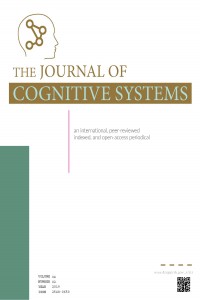Abstract
References
- [1] J. Zhang, “Basic Neural Units of the Brain: Neurons, Synapses and Action Potential,” pp. 1–38, 2019. [2] B. Ermentrout and D. Terman, “Foundations of Mathematical Neuroscience,” p. 440, 2008, doi: 10.1007/978-0-387-87708-2. [3] J. V. Tranquillo, Quantitative neurophysiology, vol.21. 2008. [4] J. Malmivuo and R. Plonsey, “Bioelectromagnetism Principles and Applications of Bioelectric,” Oxford Univ. Press, p. 512, 1995. J. Malmivuo, [5] P. E. Greenwood, L. M. Ward, Stochastic Neuron Models. 2016. [6] S. Alexander, A. Mathie, J. Peters, ION CHANNELS: Ion Channels, Vol.164, no. supplement s1. 2011. [7] R. A. Gatenby, “The role of cell membrane information reception, processing, and communication in the structure and function of multicellular tissue,” Int. J. Mol. Sci., vol. 20, no. 15, 2019, doi: 10.3390/ijms20153609. [8] A. Destexhe, Z. F. Mainen, and T. J. Sejnowski, “Synaptic Currents, Neuromodulation and Kinetic Models,” Handb. Brain Theory Neural Networks, pp. 1–14, 1995. [9] B. Eisenberg, “Ionic channels in biological membranes - Electrostatic analysis of a natural nanotube,” Contemp. Phys., vol. 39, no. 6, pp. 447–466, 1998, doi: 10.1080/001075198181775. [10] R. Brette, “Theory of action potentials,” Theory of Action Potentials, vol. 6, pp. 1–48, 2018 [11] M. Fluidity, N. Impulses, and T. A. Receptor, “The Structure and Function of the Plasma Membrane 4.1,” pp. 120–171, 2007. [12] Bard Ermentrout, G., Methematical Foundations of Neuroscience. 1990. [13] I. N. Sabir, J. A. Usher-Smith, “Electrical Properties of Cells,” A Think. Approach to Physiol., pp.1–36, 2008, doi: 10.1142/9789812832887_0001. [14] approach," presented at the Evolutionary Computation (CEC), 2010 IEEE Congress on, Barcelona 2010.
Abstract
Abstract— Neurons are linked to each other and other cells through an electrochemical mechanism. Understanding the electrical properties of neurons is essential for understanding the functioning of the brain. We can model the single neuron by standard electric circuits, and these models could be used for modeling of neuron networks. And modeling of neural networks is important for understanding the whole brain. Although we can model a single neuron by electric circuits, there is a difference between them in terms of the nature of electric charge carriers. While the main charge carrier is electrons in standard electrical circuits, neurons have a different mechanism. The main charge carriers in neurons is ions. The cell membrane is an insulator and there are some specific channels on it with different permeability for different ions. This structure of the cell membrane is very important for signal transmission in neurons. Passive modeling of the cell membrane is the basis of signal transduction in neurons.
References
- [1] J. Zhang, “Basic Neural Units of the Brain: Neurons, Synapses and Action Potential,” pp. 1–38, 2019. [2] B. Ermentrout and D. Terman, “Foundations of Mathematical Neuroscience,” p. 440, 2008, doi: 10.1007/978-0-387-87708-2. [3] J. V. Tranquillo, Quantitative neurophysiology, vol.21. 2008. [4] J. Malmivuo and R. Plonsey, “Bioelectromagnetism Principles and Applications of Bioelectric,” Oxford Univ. Press, p. 512, 1995. J. Malmivuo, [5] P. E. Greenwood, L. M. Ward, Stochastic Neuron Models. 2016. [6] S. Alexander, A. Mathie, J. Peters, ION CHANNELS: Ion Channels, Vol.164, no. supplement s1. 2011. [7] R. A. Gatenby, “The role of cell membrane information reception, processing, and communication in the structure and function of multicellular tissue,” Int. J. Mol. Sci., vol. 20, no. 15, 2019, doi: 10.3390/ijms20153609. [8] A. Destexhe, Z. F. Mainen, and T. J. Sejnowski, “Synaptic Currents, Neuromodulation and Kinetic Models,” Handb. Brain Theory Neural Networks, pp. 1–14, 1995. [9] B. Eisenberg, “Ionic channels in biological membranes - Electrostatic analysis of a natural nanotube,” Contemp. Phys., vol. 39, no. 6, pp. 447–466, 1998, doi: 10.1080/001075198181775. [10] R. Brette, “Theory of action potentials,” Theory of Action Potentials, vol. 6, pp. 1–48, 2018 [11] M. Fluidity, N. Impulses, and T. A. Receptor, “The Structure and Function of the Plasma Membrane 4.1,” pp. 120–171, 2007. [12] Bard Ermentrout, G., Methematical Foundations of Neuroscience. 1990. [13] I. N. Sabir, J. A. Usher-Smith, “Electrical Properties of Cells,” A Think. Approach to Physiol., pp.1–36, 2008, doi: 10.1142/9789812832887_0001. [14] approach," presented at the Evolutionary Computation (CEC), 2010 IEEE Congress on, Barcelona 2010.
Details
| Primary Language | English |
|---|---|
| Subjects | Electrical Engineering |
| Journal Section | Articles |
| Authors | |
| Publication Date | December 31, 2019 |
| Published in Issue | Year 2019 Volume: 4 Issue: 2 |


